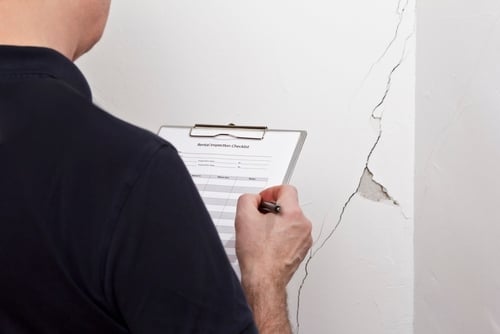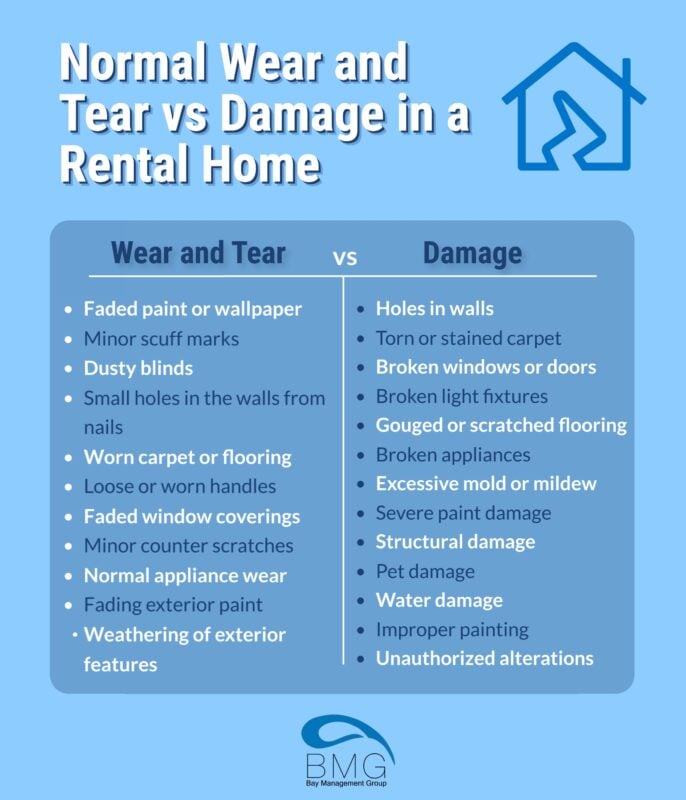When you live in a rental property, respecting and caring for the owner’s space is important. After all, you don’t own the home, so treating it with respect is vital. That said, when you live in a property for an extended period of time, it’s bound to receive some normal wear and tear. However, there’s a difference between normal wear and tear vs damage. In the video below, we’ll discover the characteristics of each, along with landlord-tenant responsibilities for rental maintenance. Read along to learn more.
Normal Wear and Tear vs Damage in a Rental Home
Discover the key to maintaining your rental home! Learn the crucial difference between normal wear and tear versus damage. Living in a rental? This video is a must-watch to ensure you’re treating your space right!
Key Moments in the Video
- 00:27 – What is Normal Wear and Tear for a Rental Property?
- 02:30 – What to do if There’s Extensive Damage
- 04:54 – Landlord and Tenant Maintenance Responsibilities
What Is Normal Wear and Tear for a Rental Property?
Normal wear and tear may be difficult to define, as laws may vary depending on the state, the age of the rental, and landlord expectations. Usually, it refers to the overall decline of a rental unit from daily tenant use. It’s important for landlords and rental property management in Baltimore to define normal wear and tear vs damage to potential renters and current tenants.
Some examples of normal wear and tear might include the following:
- Faded paint or wallpaper
- Minor scuff marks
- Dusty blinds
- Small holes in the walls from nails
- Worn carpet or flooring
- Loose or worn handles
- Faded window coverings
- Minor counter scratches
- Normal appliance wear
- Fading exterior paint
- Weathering of exterior features
Landlords and tenants should establish clear expectations about the property’s condition at the beginning of the lease through a move-in inspection report and photographs. Then, when the lease ends, a move-out inspection can help determine normal wear and tear vs damage.
Signs of Property Damage in a Rental
Unlike normal wear and tear in a rental, extensive property damage is caused by neglect or abuse, and it’s usually pretty obvious. However, signs of property damage in a rental can vary depending on the type and severity. As a landlord or property manager, it’s crucial to be vigilant and conduct regular inspections to identify any issues that require attention.
Signs of property damage in a rental may include the following:
- Holes in walls
- Torn or stained carpet
- Broken windows or doors
- Broken light fixtures
- Gouged or scratched flooring
- Broken appliances
- Excessive mold or mildew
- Severe paint damage
- Structural damage
- Pet damage
- Water damage
- Improper painting
- Unauthorized alterations
Regular property inspections, both before the tenant moves in and after they move, can help identify and document any extensive damage that occurred. Additionally, clear communication with tenants about their responsibilities for maintaining the property and reporting any issues promptly is crucial in preventing further damage. Additionally, providing guidelines on how to report maintenance and repairs can help ensure problems are addressed in a timely manner.
What to Do if There’s Extensive Damage
If there’s extensive property damage in your rental, it’s crucial to address it appropriately. You’ll want to carefully handle the situation to ensure the property is repaired, the responsible party covers the costs, and legal obligations are met. Here are a few crucial steps if there’s extensive damage from a tenant.
Next Steps for Landlords
- Assess and Document- Conduct a thorough assessment of the damage and document the extent of the destruction with photos, written notes, and detailed descriptions.
- Review Lease Agreement- Refer to the lease agreement to understand the tenant’s responsibilities, including property maintenance and repair obligations.
- Notify the Tenant- Contact the tenant to inform them about the extensive damage and discuss the situation. Although it may be challenging, it’s crucial to maintain a professional and non-confrontational tone during your discussions.

- Gather Repair Estimates- Obtain repair estimates from reliable contractors to determine the cost of repairs. You may even consider multiple estimates to help ensure accuracy.
- Discuss Responsibility- Based on the lease agreement, local laws, and evidence, discuss with the tenant their responsibility for the damage and potential repair costs.
- Legal Considerations- If the tenant disputes responsibility or refuses to cooperate, consult legal counsel to understand your rights and options going forward.
- Document All Communication- Keep detailed records of all communication with the tenant, including emails, phone calls, and in-person conversations.
- Repair Process- Initiate the repair process with reputable contractors and ensure repairs are done to restore the property to its original condition.
- Deduct from Security Deposit- If the tenant is responsible for the damage, follow legal procedures for deducting repair costs from their security deposit. With that, you’ll want to give the tenant an itemized list of deductions.
- Final Inspection- After repairs are completed, conduct a final inspection to ensure the property is restored to its pre-damage condition.
- Dispute Resolution- If disagreements arise over responsibility or repair costs, consider mediation or legal proceedings to handle the dispute.
- Prevent Future Incidents- Discuss preventative measures with the tenant to avoid similar situations in the future. Give each tenant guidelines for property care and regular rental maintenance.
Landlord and Tenant Rental Responsibilities
Maintaining a rental home involved shared responsibilities between landlords and tenants. As such, clearly defining these responsibilities can help prevent disputes and ensure a harmonious living arrangement. That said, here are some of the primary responsibilities regarding rental property damage.
Landlord Maintenance Responsibilities
- Property Maintenance- Ensure the rental is habitable and meets safety and health standards. Additionally, promptly address structural issues, plumbing problems, electrical faults, and other necessary repairs.
- Regular Inspections- Conduct periodic inspections to assess the property’s condition and identify any maintenance or repair needs.
- Safety and Security- Install and maintain smoke detectors, carbon monoxide detectors, and fire extinguishers. Additionally, ensure the unit has adequate safety measures, like secure locks on doors and windows.
- Exterior Upkeep- Maintain the property’s exterior, including landscaping, roof repairs, and paint.

- Providing Essential Services- Ensure that utilities, such as water, heating, and electricity, are operational and available to tenants.
- Security Deposits- Adhere to legal requirements for handling security deposits, including proper documentation and timely return.
Tenant Maintenance Responsibilities
- Cleanliness and Care- Keep the rental property clean and free from excessive clutter to prevent damage and maintain a healthy living environment.
- Reporting Maintenance Issues- Promptly report any maintenance or repair issues to the landlord to prevent minor problems from escalating.
- Minor Repairs- Attend to minor repairs and maintenance tasks resulting from regular wear and tear, such as changing light bulbs and replacing air filters.
- Preventative Maintenance- Perform routine tasks that prevent damage, such as cleaning gutters, changing HVAC filters, and maintaining appliances.
- Respecting Property- Use the property responsibly, avoiding damage caused by negligence, misuse, or unauthorized alterations.
- Following Lease Terms- Adhere to lease terms, including rules regarding pets, subleasing, and property alterations.
- Security Deposits- Understand and follow procedures related to security deposits, including expectations for returning the property to its original condition.
Find Reliable Tenants Today With BMG
Whether you own or live in rental properties, it’s crucial to learn the differences between normal wear and tear vs damage. That way, you know how to properly care for the rental home, and landlords know how to spot real property damage.
Managing and caring for rental properties requires a lot of time and effort, which some landlords don’t have. As such, many busy landlords resort to hiring comprehensive rental management services. Luckily, Bay Property Management Group offers full-service management for landlords near Baltimore, Philadelphia, Northern Virginia, or Washington, DC. So, if you’re looking for someone to help you with all the crucial rental processes, like marketing, tenant screening, maintenance, and more, contact BMG today.

